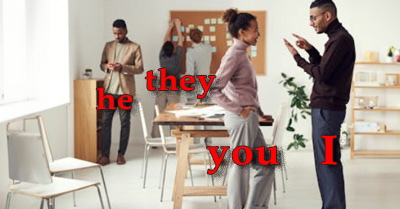This lesson is a quick summary of personal pronouns and possessive determiners in all cases. It includes several exercises. For more detailed lessons, see the list of individual lessons on pronouns.
Navigate This Page
Practice
Members-Only
Summary Table
| Person |
Singular |
Plural |
| Subject |
I, you, he, she, it |
we, you (you all), they |
| Object |
me, you, him, her, it |
us, you, them |
| Possessive (determiner) |
my, your, his, her, its |
our, your, their |
| Possessive (pronoun) |
mine, yours, his, hers, — |
ours, yours, theirs |
| Reflexive |
myself, yourself, himself, herself, itself |
ourselves, yourselves, themselves |
| Reciprocal |
|
each other
one another |
First, Second, and Third Person
In grammar, the pronouns can be first, second, and third person. Pronouns are also singular or plural when they refer to one person (I, you, he, she, it) or two or more people (we, you, they).
First person pronouns singular and plural are “I” and “we." The first person refers to the person or persons speaking.

fauxels | Pexels
The second person pronoun “you” is both singular and plural. The second person refers to the person you are speaking to.
Third person pronouns are both singular (”he,” “she,” “it”) and plural (”they”). The third person refers to the person you and I are talking about.
Case
Pronouns have different grammatical functions in the sentence. These are called the grammatical case of the pronoun: Subject, object, possessive, and reflexive.
Subject
The subject is the person or thing doing something or acting on the verb. You call this the subjective or nominative case.
Subjective pronouns
Examples
We are learning English.
Do you speak English?
He speaks French, and she speaks Italian.
Object
The object is receives the action or effect expressed by the verb. The objective case is also called the accusative (direct object) and dative (indirect object) cases.
The object case is used after prepositions (after me, unlike her, beneath us).
Objective pronouns
Examples
Please give me that box.
Please give it to me.
Mr. Smith speaks to us only in English.

Tima Miroshnichenko (edited) | Pexels
See the list of exercises at the end of this page if you would like to practice these pronouns.
Possessive
Possessive determiners and possessive pronouns indicate ownership, relationship, or association.
Possessive Determiners
Possessive determiners (my, your, her, their) indicate that someone has or owns something. They can also show a relationship or association between people (for example, “my friend" or “my head").
Determiners are not true pronouns, but they work similarly.
Possessive determiners
Examples
This is my house.
Joanne and her husband are from California..
The children and their friends are playing soccer.

Yakup Polat | Pexels
Possessive Pronouns
Possessive pronouns (mine, yours, hers, theirs) are true pronouns as they replace nouns. They show ownership (my car – mine), a relationship (her husband – hers), or an association (our hair – ours).
Possessive pronouns
Examples
John’s dog is brown. Mine is black. (mine = my dog)
Are those pencils mine or yours? (my pencils or your pencils)
— Are these your parents’ books?
— No. These are mine. Those over there are theirs.
( mine = my books; theirs = their books)
See the list of exercises at the end of this page if you would like to practice these pronouns.
Reflexive pronouns (Object)
Reflexive pronouns (myself, yourself, yourselves, themselves) show that the subject and the object of the sentence refer to the same person.
Reflexive pronouns can also be used to mean you do something alone or without any help (for example, “Students must complete their work themselves so that they can learn.”)
Reflexive pronouns
myself
yourself
himself, herself, itself
ourselves
yourselves
themselves
Examples using reflexive pronouns
I am buying myself a book.
John and Susan drive themselves to work every morning.
That knife is very sharp! Don’t cut yourself on it.

mali maeda | Pexels
Expression: by oneself
The expression “by oneself” (by myself, by yourself, by itself, by ourselves, etc.) means alone or without someone’s help or interference.
The little boy can ride the bicycle by himself.
Janet is going to the movies by herself.
You can set this TV to turn itself off.
Reciprocal Pronouns “Each Other” and “One Another”
The reciprocal pronoun “each other” or “one another" is used with plural subjects and shows that the individuals in the subject both perform the action and receive the effect of the action.
There is a small difference in meaning between “each other” and “one another.” You can use “each other” when two people are involved and “one another” when more than two people are involved. In practice, however, people do not follow this rule in spoken or written language.
Examples using reciprocal “each other"
John and Mary love each other very much.
We need to help each other.
People shake each other’s hands when they arrive at a meeting.
We help one another when there is a big project at work.
In some countries, friends kiss one another on the cheek when they meet.
Related Lessons
List of Exercises on Pronouns
The exercises below include PDF files.
Subject and Object
Practice 1.1. Answer questions in complete sentences and using the correct subject or object pronouns
Practice 1.2. Answer questions in complete sentences and using the correct subject or object pronouns
Personal Pronouns and Determiners
Practice 2.1. Fill in the blanks using personal pronouns and possessive determiners.
Practice 2.2. Fill in the blanks using personal pronouns and possessive determiners.
Possessive Pronouns and Possessive Determiners
Practice 3.1. Fill in the blanks using personal pronouns, possessive pronouns and possessive determiners.
Practice 3.2. Fill in the blanks using personal pronouns, possessive pronouns and possessive determiners.
Reflexive and Reciprocal Pronouns
Practice 4.1. Fill in the blanks using reflexive and reciprocal pronouns.
Members-Only Quizzes
Snap Language members on Ko-Fi can access members-only materials.
All Pronouns
Quiz 1, Quiz 2, and Quiz 3. Fill in the blanks using any of the pronouns in the lesson.
Possessive Determiners and Pronouns
Quiz 4 and Quiz 5. Fill in the blanks using possessive determiners and possessive pronouns.
Reflexive Pronouns
Quiz 6 and Quiz 7. Fill in the blanks using reflexive pronouns.
Congratulations on completing this material!

Thanks to our supporters!
This material has been made possible by supporters like you. Learn how you can support us.

“What should I learn next?”
Check out the double genitive or use the navigation buttons to choose another skill or lesson.
Thank you for Supporting Snap Language
Snap Language supporters make the creation of these materials possible.
Learn how you can support our work, get perks, and help us continue creating high-quality materials.
You can support us by simply white-listing this site.